Summary of key points
The main distinction between Hunan Beef and Kung Pao Beef lies in their flavor profiles and ingredients. Hunan beef, from the Hunan region of China, is known for its spicy and slightly smoky taste, often using fresh chili peppers and incorporating a variety of vegetables. Kung Pao Beef, a Sichuan cuisine dish, is characterized by its sweet and spicy sauce, made with hoisin sauce, soy sauce, and dried chili peppers, and commonly includes peanuts.
If you love Chinese food, then the debate between Hunan beef and Kung Pao beef is likely something that has come up in conversation before.
But what’s the difference?
From differences in origin to regional variations and beyond, this delicious dish is full of nuances.
If you’re curious about both dishes and want an answer to your burning question: what are their unique characteristics?
Then this blog post is for you!
Read on to find out all about Hunan vs Kung Pao Beef – understanding when each best fits onto your dinner table.

What is Hunan Beef?
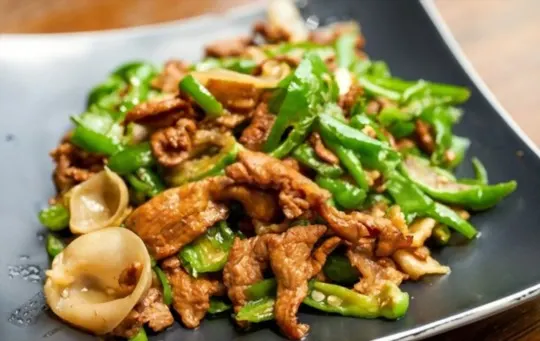
Hunan Beef is a traditional Chinese dish that comes from the Hunan province of China.
This dish is known for its spicy and bold flavors and is popular in many Chinese restaurants worldwide.
Hunan Beef features thin slices of beef that are stir-fried with vegetables such as peppers, onions, and celery.
The dish is typically seasoned with garlic, ginger, soy sauce, and chili peppers.
Hunan Beef can be customized to suit individual tastes.
For example, some people prefer their Hunan Beef extra spicy with lots of chili peppers added to the mix.
Others prefer it milder with less spice.
In summary, Hunan Beef is a classic Chinese dish originating from the Hunan province of China.
It features thin slices of beef stir-fried with a range of vegetables and seasonings such as garlic, ginger and chili peppers.
What is Kung Pao Beef?
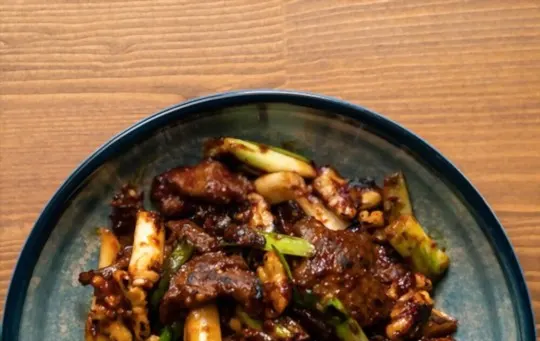
Kung Pao Beef is a popular Chinese dish that is known for its spicy and savory flavor.
It originated in the Sichuan province of China and has become a staple in Chinese cuisine around the world.
Kung Pao Beef is typically cooked in a wok over high heat until all the ingredients are evenly coated with the flavorful sauce.
The dish is then served hot with rice or noodles.
In terms of taste and texture, Kung Pao Beef has a unique combination of sweetness from the bell peppers, saltiness from the soy sauce, spiciness from chili peppers, and crunchiness from the roasted peanuts.
Overall, Kung Pao Beef is a dynamic dish that packs layers of flavor in every bite.
Differences Between Hunan Beef and Kung Pao Beef
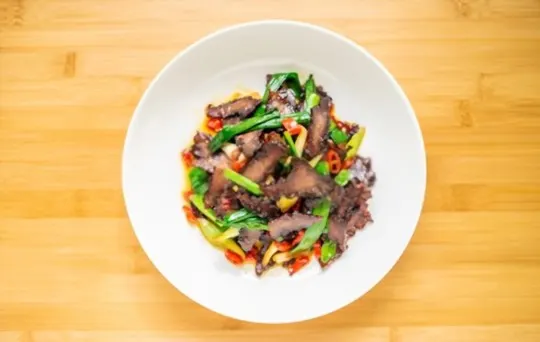
When it comes to Chinese cuisine, there are numerous dishes that have distinct flavors and ingredients.
Hunan Beef and Kung Pao Beef are two such examples of popular Chinese dishes that differ in several aspects.
Now that we have a clear picture of the distinctions between Hunan Beef and Kung Pao Beef from a table perspective, let’s discuss the heading in more detail.
When you order Hunan beef at a restaurant, you can expect to experience spicy and sour flavors.
The dish typically features copious amounts of chili peppers as its main seasoning ingredient, along with soy sauce, ginger, garlic and fermented black beans.
As for vegetables used in the preparation process? Often green beans or cauliflower are used to complement the beef’s spice levels.
On the other hand, if you choose Kung Pao beef instead of Hunan beef when ordering Chinese food at a restaurant near you, get ready to taste salty-sweet-spicy flavors complemented with peanuts.
Its sauce base comprises soy sauce (often light), vinegar (black rice or balsamic) mixed with sugar (white).
In terms of vegetables used in this dish? Bell peppers are frequently included along with onions to add flavor.
Origin
Hunan Beef is named after the Hunan Province in Southern China while Kung Pao Beef is named after Ding Baozhen, a governor in Sichuan Province during the Qing Dynasty.
The history and cultural significance behind these dishes can provide context for understanding their unique flavor profiles and preparation methods.
Hunan cuisine is known for its bold and spicy flavors that showcase a variety of peppers and fermented ingredients.
On the other hand, Sichuan cuisine focuses on numbing spices such as Sichuan peppercorns.
It’s important to note that both dishes have evolved over time and may vary depending on regional interpretations or personal preferences.
However, understanding their roots can offer some insight into what sets them apart from each other.
Ingredients Used
One of the key factors that differentiate Hunan beef and Kung Pao beef is the selection of ingredients used to make them.
While both dishes are beef-based, their individual ingredient list contributes significantly to their unique flavor, aroma, and spiciness.
Hunan beef contains vegetables such as carrots and green beans.
Kung Pao beef, on the other hand, uses a different vegetable composition – green and red bell peppers instead of carrots and green beans.
Both dishes contain onions, scallions, garlic, ginger with variations in soy sauce type (normal versus dark) and sugar type (brown versus granulated).
Moreover, by deciphering these ingredients’ flavors and characteristics, one can discern the complexity of each dish’s initial taste.
By analyzing each ingredient’s role in creating a particular flavor profile specific to Hunan or Kung Pao style dishes adds an important dimension to any connoisseur’s understanding.
Flavor and Spice Level
When it comes to Hunan Beef and Kung Pao Beef, their distinct flavors and spice levels differentiate them from each other.
Hunan Beef is known for its spiciness, while Kung Pao Beef has a combination of sweet and savory flavors with a mild level of spice.
As you can see from the table above, the main difference in flavor between Hunan Beef and Kung Pao Beef is that Hunan Beef has a much higher spice level than Kung Pao Beef.
This is because Hunan cuisine is traditionally known for its use of spicy ingredients such as chili peppers and Sichuan peppercorns.
On the other hand, Kung Pao beef has a more balanced flavor profile with sweet and savory notes from ingredients like soy sauce, sugar, vinegar, and peanuts.
In terms of texture, both dishes use tender flank steak strips to give them a chewy yet melt-in-your-mouth consistency.
The vegetables used in both dishes also play an important role in their overall flavor profile – bell peppers are commonly used in Hunan beef to add crunchiness while garlic is used for its pungent aroma.
In contrast, Kung Pao beef often includes red chili peppers for an added kick.
Overall, if you’re looking for a dish with bold flavors and high levels of spiciness then Hunan Beef may be your go-to option.
However, if you prefer something that’s more balanced in flavor with just a hint of heat then Kung Pao beef could be a perfect choice.
Preparation Methods
When it comes to preparing Hunan Beef and Kung Pao Beef, there are different methods involved that contribute to their unique flavors and textures.
Let’s take a closer look at their preparation methods.
For Hunan Beef, the beef strips are usually sliced thin against the grain to ensure tenderness.
They’re then marinated in a mixture of soy sauce, rice wine or sherry, and cornstarch for about 30 minutes to an hour before cooking.
The vegetables used in the dish can vary but typically include bell peppers, onions, mushrooms, and green beans.
When stir-frying the beef and vegetables together over high heat, chefs often add garlic, ginger, chili paste or black bean sauce for extra flavor complexity.
On the other hand, Kung Pao Beef involves cubing the beef into bite-sized pieces that are also marinated in soy sauce and sesame oil.
The star ingredients here are the peanuts and spicy Sichuan peppers that give this dish its iconic crunchiness and tingling heat level.
Chefs may also add some hoisin sauce or vinegar when stir-frying everything together over high heat.
Overall, both dishes offer bold flavors that can satisfy any meat lover’s cravings.
Serving Suggestions
If you’re looking to try either Hunan beef or Kung Pao beef, there are a variety of serving suggestions that can help take your meal to the next level.
Here are some ideas for each dish:
For Hunan beef, consider serving it with steamed rice and stir-fried vegetables such as bok choy, snow peas, or broccoli.
You could also add a side of spicy tofu or dumplings to complement the flavors of the Hunan beef.
Kung Pao beef is often served with diced vegetables such as bell peppers, onions, and celery.
This spicy dish pairs well with steamed white rice or noodles.
Consider adding a side of egg rolls or potstickers for a complete Chinese-inspired meal.
To really elevate your dining experience with either dish, consider pairing them with traditional Chinese tea or a cold beer.
The combination of spicy and savory flavors in both dishes make them ideal candidates for sipping on a light beverage while enjoying your meal.
No matter how you choose to serve your Hunan or Kung Pao beef dishes, remember that the flavors will vary depending on where you order from and who prepares it.
Don’t be afraid to experiment with different seasonings and ingredients to truly make it your own.
Similarities Between Hunan Beef and Kung Pao Beef
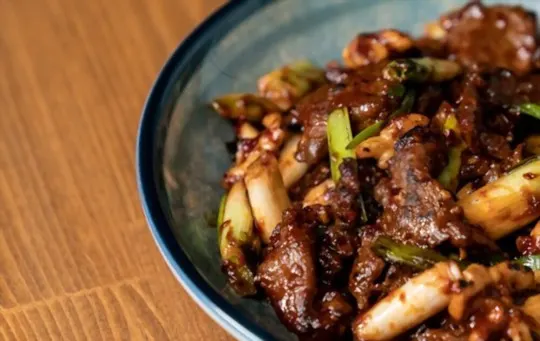
Hunan beef and Kung Pao beef are two popular dishes in Chinese cuisine that are often confused with one another.
Despite their differences, there are a few similarities between the two that make them both delicious options to try when looking for a spicy and flavorful meal.
As visible from the table above, Hunan beef and Kung Pao beef share similar characteristics despite their differences in flavor profiles.
For example, they both typically use beef as their main protein source and stir-frying as their cooking method.
Furthermore, they both originated in the Sichuan region of China which explains why they both have spicy flavors thanks to common ingredients like garlic, ginger, and chili peppers.
Overall, while Hunan beef and Kung Pao beef may have slight differences in how they taste, they still share some commonalities that make them stand out among other Chinese cuisine options.
Popular Hunan Beef and Kung Pao Beef Recipes
Popular Hunan Beef and Kung Pao Beef Recipes are two of the most commonly found Chinese dishes available in many restaurants across the world.
These dishes have some similarities but also come with some differences, making them unique in their own way.
When it comes to preparation, both dishes use similar ingredients such as beef, soy sauce, ginger, garlic, and vegetables like bell peppers or onions.
However, what sets them apart is the way they are cooked and seasoned.
While both recipes involve spicy beef stir-fries as their base ingredient, they use different sauces and additional flavors to elevate their taste.
Hunan Beef relies on spiciness to give it a unique flavor while Kung Pao Beef uses a combination of spicy, salty and sweet tastes.
Additionally, Hunan beef tends to be more saucy than Kung Pao beef.
Conclusion
Now that we have explored the popular Hunan Beef and Kung Pao Beef recipes in detail, let’s summarize the differences between the two dishes.
In general, Hunan beef has more vegetables and less protein when compared to Kung Pao beef.
However, both dishes are typically served with rice as an accompaniment.
While Hunan Province has its own signature spicy cuisine famous for using chilies and pickling techniques to preserve food items which contribute to unique flavours in their dishes; Sichuan’s cuisine is known for its hot and tangy flavours due to savory sauces made from chili bean paste such as Doubanjiang.
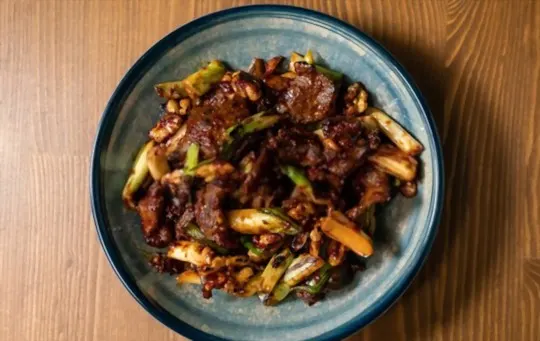
Hunan Beef vs Kung Pao Beef: What’s the Difference?
Ingredients
- Hunan Beef
- Kung Pao Beef
Instructions
- Choose between two items based on your preference and availability.
- Follow the cooking directions for your chosen option, using the appropriate ratio of ingredients.
- Prepare it according to your desired recipes.
- Incorporate them into your dish, adjusting the amount to suit your taste.
- Enjoy the unique taste experience and experiment with different dishes to explore their versatility.

Andrew Gray is a seasoned food writer and blogger with a wealth of experience in the restaurant and catering industries. With a passion for all things delicious, Andrew has honed his culinary expertise through his work as a personal chef and caterer.
His love for food led him to venture into food writing, where he has contributed to various online publications, sharing his knowledge and insights on the culinary world. As the proud owner of AmericasRestaurant.com, Andrew covers a wide range of topics, including recipes, restaurant reviews, product recommendations, and culinary tips.
Through his website, he aims to inspire and educate fellow food enthusiasts, offering a comprehensive resource for all things food-related.
